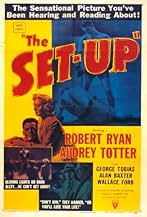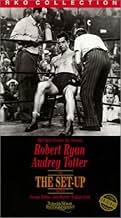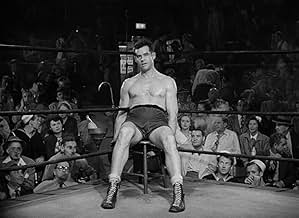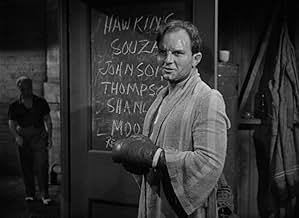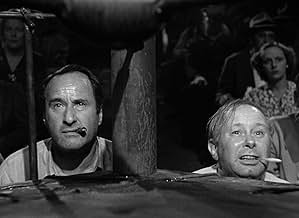ÉVALUATION IMDb
7,8/10
11 k
MA NOTE
S'attendant à la perte habituelle, un manager de boxe prend des pots-de-vin à un gangster des paris sans en parler à son combattant.S'attendant à la perte habituelle, un manager de boxe prend des pots-de-vin à un gangster des paris sans en parler à son combattant.S'attendant à la perte habituelle, un manager de boxe prend des pots-de-vin à un gangster des paris sans en parler à son combattant.
- Nominé pour le prix 1 BAFTA Award
- 2 victoires et 2 nominations au total
Hal Baylor
- Tiger Nelson
- (as Hal Fieberling)
Kevin O'Morrison
- Moore
- (as Kenny O'Morrison)
Herbert Anderson
- Husband
- (uncredited)
Larry Anzalone
- Mexican Fighter
- (uncredited)
Arthur Berkeley
- Cafe Patron
- (uncredited)
Phil Bloom
- Minor Role
- (uncredited)
Burman Bodel
- Man
- (uncredited)
Avis en vedette
Bill "Stoker" Thompson is 34, not old perhaps but in the world of boxing that makes him an old man. Despite the protestations of his wife Julie, Stoker still believes that one more punch, one more fight will see him making it into the marquee fights and the big time rather than being on the support bill. As he waits in the dressing room full of similar hopefuls (some his age and tired, others just starting and full of big dreams) his trainer is busy making the fix with the opposition for Stoker to go down like a $10 ho and not last the distance. However, Stoker isn't told as his manager assumes that Stoker losing is a given and that the "fix" is unnecessary and easy money for them all; however with Stoker feeling this is "the one", it may not be that simple.
Although Rocky is the one that most people will throw at you when you ask them to name a great boxing movie, The Set-Up is much, much more interesting as its aspirations are empty, its sights never getting much beyond the gutter and the men merely small players in a game that never plans for them to win. The narrative is essentially about Stoker entering a fight not aware that he has already been bought to lose but the actual film is much better than this limited plot suggests. For much of the first third we are treated to an intimate look at the small time boxers whether it be the punch-drunk old timers or the youngster who believe that they will only be doing this level for one or two fights before hitting it big. This is the reality as much as we love to see the Rocky tale of the underdog getting his day in reality the underdogs of life generally remain just that underdogs. In this section of the film this is very well painted and, although the characters are not deep enough to be people they are definitely well enough written to be interesting and engaging.
The other two thirds of the film are concerned with the fight and the aftermath, with the fight taking up the majority of the second half of the film. The fight is realistic and tense throughout, I was genuinely unsure how it would go. The aftermath is short and punchy (sorry!) and is effectively dark and gritty for it. The end result is a film that is dark, low key and gripping throughout; it exists in the gutter, in the small time where all our characters seem destined to remain regardless of heart or talent. The cast deliver well, particularly the lead role from former college boxer Ryan. He is really in touch with his character and delivers convincingly in his dialogue, his boxing and his mannerisms; while in the dressing room his facial responses to other boxers show thoughts within his head and conflicting emotions that his experience and age allow him. He is the dominant figure of the film and his is a great performance. Totter is a little less refined but her emotional delivery works well in both of her main scenes with Ryan although her wandering the streets could perhaps have been trimmed a little bit. The support cast are less well written but do still play their parts well enough but it is Ryan's film and worth seeing for him alone.
Luckily he is not the only reason to see it as the film is engaging, well written, dark, gritty, tense and very enjoyable. The lower number of votes (and potentially therefore, younger viewers) is a tragic state of affairs considering the class on display in this short punchy product and I for one will be answering "The Set-Up" when asked to name a great boxing movie.
Although Rocky is the one that most people will throw at you when you ask them to name a great boxing movie, The Set-Up is much, much more interesting as its aspirations are empty, its sights never getting much beyond the gutter and the men merely small players in a game that never plans for them to win. The narrative is essentially about Stoker entering a fight not aware that he has already been bought to lose but the actual film is much better than this limited plot suggests. For much of the first third we are treated to an intimate look at the small time boxers whether it be the punch-drunk old timers or the youngster who believe that they will only be doing this level for one or two fights before hitting it big. This is the reality as much as we love to see the Rocky tale of the underdog getting his day in reality the underdogs of life generally remain just that underdogs. In this section of the film this is very well painted and, although the characters are not deep enough to be people they are definitely well enough written to be interesting and engaging.
The other two thirds of the film are concerned with the fight and the aftermath, with the fight taking up the majority of the second half of the film. The fight is realistic and tense throughout, I was genuinely unsure how it would go. The aftermath is short and punchy (sorry!) and is effectively dark and gritty for it. The end result is a film that is dark, low key and gripping throughout; it exists in the gutter, in the small time where all our characters seem destined to remain regardless of heart or talent. The cast deliver well, particularly the lead role from former college boxer Ryan. He is really in touch with his character and delivers convincingly in his dialogue, his boxing and his mannerisms; while in the dressing room his facial responses to other boxers show thoughts within his head and conflicting emotions that his experience and age allow him. He is the dominant figure of the film and his is a great performance. Totter is a little less refined but her emotional delivery works well in both of her main scenes with Ryan although her wandering the streets could perhaps have been trimmed a little bit. The support cast are less well written but do still play their parts well enough but it is Ryan's film and worth seeing for him alone.
Luckily he is not the only reason to see it as the film is engaging, well written, dark, gritty, tense and very enjoyable. The lower number of votes (and potentially therefore, younger viewers) is a tragic state of affairs considering the class on display in this short punchy product and I for one will be answering "The Set-Up" when asked to name a great boxing movie.
The Set-Up is directed by Robert Wise and stars Robert Ryan & Audrey Totter. The screenplay was adapted by Art Cohn from a 1928 poem written by Joseph Moncure March. The story (played out in real time) sees Ryan as Stoker Thompson, a 35 year old nearly washed up boxer still trundling around the circuit believing he's still got what it takes to become a champ. In spite of pleas from his fretful wife, Julie (Totter), Stoker gets in the ring with Tiger Nelson (Hal Baylor), a man 12 years younger. Unbeknownst to Stoker, though, his manager Tiny (George Tobias) has struck a deal with underworld gangster Little Boy (Alan Baxter on prime sweaty and icy form) for him to take a dive and let Nelson win.
What first struck me the most watching this was just how vile everyone apart from the boxers are. The fighters are actually the only ones with honesty and integrity running through their veins. These guys are the ones with the self respect being a chief issue for them, they are fighting not just for glory, but for a basic human trait. The first half of the film puts us in the boxers changing room as the fighters wait to go out into the ring. Here we see the number of noble pugilists stripped back to reveal either their fears or their blind beliefs - while they in turn wait to see who comes back victorious or defeated. As they chat amongst themselves the atmosphere is palpable and Wise excellently uses cutaways to the excitable and blood thirsty crowd. The impact is to that of a gladiatorial arena and shows the sport to be seedy yet utterly beguiling at the same time.
Then it's on to Stoker's fight where Ryan is terrific (he actually boxed for College for 4 years). Thompson is a character so stand up, yet driven by foolish pride, it puts Stallone's Rocky Balboa firmly in the shade, his whole "just one punch away" mantra is truly wonderful and heartfelt and leads to one of those endings that are frustratingly brilliant in its bittersweet closure. The whole fight with Nelson has a beautiful fluidity about it (former pro boxer John Indrisano choreographed it), with Milton R. Krasner's photography keeping it grim and humanistic - both in the ring and out on the darkly lit L.A. streets as Totter's conflicted wife ponders a potential battering for her stoic husband.
Boosted up by a towering performance from Ryan, and dripping with a film noir sense of desolation, The Set-Up is a simple but powerful boxing gem. A film that gets down to the nitty-gritty of the fighters and the seedy people that surround them. 9/10
What first struck me the most watching this was just how vile everyone apart from the boxers are. The fighters are actually the only ones with honesty and integrity running through their veins. These guys are the ones with the self respect being a chief issue for them, they are fighting not just for glory, but for a basic human trait. The first half of the film puts us in the boxers changing room as the fighters wait to go out into the ring. Here we see the number of noble pugilists stripped back to reveal either their fears or their blind beliefs - while they in turn wait to see who comes back victorious or defeated. As they chat amongst themselves the atmosphere is palpable and Wise excellently uses cutaways to the excitable and blood thirsty crowd. The impact is to that of a gladiatorial arena and shows the sport to be seedy yet utterly beguiling at the same time.
Then it's on to Stoker's fight where Ryan is terrific (he actually boxed for College for 4 years). Thompson is a character so stand up, yet driven by foolish pride, it puts Stallone's Rocky Balboa firmly in the shade, his whole "just one punch away" mantra is truly wonderful and heartfelt and leads to one of those endings that are frustratingly brilliant in its bittersweet closure. The whole fight with Nelson has a beautiful fluidity about it (former pro boxer John Indrisano choreographed it), with Milton R. Krasner's photography keeping it grim and humanistic - both in the ring and out on the darkly lit L.A. streets as Totter's conflicted wife ponders a potential battering for her stoic husband.
Boosted up by a towering performance from Ryan, and dripping with a film noir sense of desolation, The Set-Up is a simple but powerful boxing gem. A film that gets down to the nitty-gritty of the fighters and the seedy people that surround them. 9/10
This is an awfully hard and brutal movie, produced at the end of the brief, rather high end Dore Schary regime at RKO (1946-48), just prior to Howard Hughes' purchase of the studio, which led to the company's slow, agonizing decline that forced it, or rather its new owners, to close it down ten years later. It's the story of an aging boxer, over the hill but still harboring a measure of optimism, really a sort of pride. In this tragic role Robert Ryan is superb. Tough, compassionate, deeply ethical, realistic, and yet with just enough of the dreamer in him to keep him emotionally afloat, Stoker Thompson represents the best qualities of the so-called common man. In an earlier, more heroic age, he might have been a knight; but alas we do not live in such a time, thus his personal qualities go unnoticed by all but his wife. In this role, Audrey Totter is almost as good as Ryan. Some of her scenes are unforgettable, as when she tears up the ticket to her husband's fight and throws it over the bridge into the steam of an oncoming train; or when she watches a bunch of silly teenagers "play" at boxing with a couple of performing puppets, which at first amuses her, then horrify her when she realizes her own and her husband's fate in this little "play" scene.
The film is a masterpiece of design and composition. Director Robert Wise never made a better picture than this. The movie, like High Noon, plays out in real time, and as a result has an air of urgency to it. Adapted from a poem by Joseph Moncure March, which tells essentially the same story, but with the main character a black man, Wise and scenarist Art Cohn take considerable liberties here that purists' might not care for. In the poem the setting is New York, while in the movie it's a tank town called Paradise City, a far cry from New York even if it's in fact less than a hundred miles away, upstate, or in New Jersey or Pennsylvania. The film never makes this clear. Here and there hints are dropped that the setting might be California. It doesn't matter. The Paradise City boxing arena is a place for young guys on their way up and old guys on their way down. It's a million miles from Madison Square Garden, and that's all that counts.
The film's settings are beautifully realized; and Milton Krasner's photography is no less brilliant. The central street, all blinking lights, and yet shadowy and black in odd places, is a perfect visual metaphor for the action of the film; while seldom have the denizens of a small city looked more menacing. Men in garish ties and fedoras jostle each other on the sidewalk as they pass by. They are a hard, apathetic breed, and hungry for sensation. Inside the arena we see humanity at its least admirable, as there is an undercurrent of sadism in even the most innocuous-seeming fight fans, such as a blind man ("go for his eyes!). We sense that these people come not so much to see a favorite boxer win as a hapless boxer lose.
In the center of all this is Stoker, a man with character surrounded by people who couldn't care less. As his handlers, a porcine, toothpick-chewing Percy Helton, and a thick-witted George Tobias, are superb. In a somewhat smaller role, Edwin Max, in pinstripe suit, with pencil-line mustache's, and what look like three soggy Salada tea bags under each eye, is visually perfect as a small-time something, not even hood, just a guy who runs around and does things for the big guy, played by Alan Baxter, a sort of anti-Stoker, a man without qualities who goes to great lengths to show that he has class and principles, when in fact he has neither. The man is a monster, and he doesn't even have guts. When Stoker punches him in the face he lets his goons do the dirty work.
The interior lives of the two main characters in this film suggest an affinity with the humanistic stoicism Hemingway, while the surface is closer to Weegee and Walker Evans. Overall, though, the movie is pure RKO; its courage-in-the-face-of-adversity theme suggests, almost uncannily, this odd man out among the major studios' history and future, and the best qualities of those who worked there.
The film is a masterpiece of design and composition. Director Robert Wise never made a better picture than this. The movie, like High Noon, plays out in real time, and as a result has an air of urgency to it. Adapted from a poem by Joseph Moncure March, which tells essentially the same story, but with the main character a black man, Wise and scenarist Art Cohn take considerable liberties here that purists' might not care for. In the poem the setting is New York, while in the movie it's a tank town called Paradise City, a far cry from New York even if it's in fact less than a hundred miles away, upstate, or in New Jersey or Pennsylvania. The film never makes this clear. Here and there hints are dropped that the setting might be California. It doesn't matter. The Paradise City boxing arena is a place for young guys on their way up and old guys on their way down. It's a million miles from Madison Square Garden, and that's all that counts.
The film's settings are beautifully realized; and Milton Krasner's photography is no less brilliant. The central street, all blinking lights, and yet shadowy and black in odd places, is a perfect visual metaphor for the action of the film; while seldom have the denizens of a small city looked more menacing. Men in garish ties and fedoras jostle each other on the sidewalk as they pass by. They are a hard, apathetic breed, and hungry for sensation. Inside the arena we see humanity at its least admirable, as there is an undercurrent of sadism in even the most innocuous-seeming fight fans, such as a blind man ("go for his eyes!). We sense that these people come not so much to see a favorite boxer win as a hapless boxer lose.
In the center of all this is Stoker, a man with character surrounded by people who couldn't care less. As his handlers, a porcine, toothpick-chewing Percy Helton, and a thick-witted George Tobias, are superb. In a somewhat smaller role, Edwin Max, in pinstripe suit, with pencil-line mustache's, and what look like three soggy Salada tea bags under each eye, is visually perfect as a small-time something, not even hood, just a guy who runs around and does things for the big guy, played by Alan Baxter, a sort of anti-Stoker, a man without qualities who goes to great lengths to show that he has class and principles, when in fact he has neither. The man is a monster, and he doesn't even have guts. When Stoker punches him in the face he lets his goons do the dirty work.
The interior lives of the two main characters in this film suggest an affinity with the humanistic stoicism Hemingway, while the surface is closer to Weegee and Walker Evans. Overall, though, the movie is pure RKO; its courage-in-the-face-of-adversity theme suggests, almost uncannily, this odd man out among the major studios' history and future, and the best qualities of those who worked there.
Overshadowed by the more heralded The Champion in 1949, I like this movie better. Maybe the grittiness of this one with its unrelentingly seedy environment and no obvious feel good outcome made it less popular at the time. After seeing it for years on cable, a most welcome sight on DVD. Certainly an Oscar caliber performance by Ryan. The direction and cinematograpy also Oscar worthy. The boxing match itself is a classic, convincingly choreographed. The whole cast down to the smallest part is uniformly fine, with many memorable faces. The sense of anxiety we feel for Stoker mixed with hope and fleeting elation makes quite a compelling story. The movie is 71 minutes and is in `real time` ****1/2 out of *****
I love Robert Ryan films. Whether playing a scum bag or a hero, his gritty and realistic performances have always impressed me. One of his better films is this boxing flick. Ryan is an old washed-up boxer who is expected to take a dive. Through much of the film, you really don't know what he will do--throw the fight or try to salvage some of his dignity. And, I gotta say that the boxing scenes are brutal and realistic--it really HURTS to watch the fight. If you like the films THE HARDER THEY FALL or REQUIEM TO A HEAVYWEIGHT, then is this movie for you! In fact, try watching all three to get a look at the less glamorous and seedy side of boxing.
Le saviez-vous
- AnecdotesThe clock on the square at the beginning shows 9:05 PM, and the same clock at the end shows 10:16 PM. The movie takes place in real time.
- GaffesAfter the big fight, when Stoker is in the locker room, he opens his locker and takes out his clothes and shoes. In two subsequent shots his shoes are back in the locker, and then in a fourth shot he removes his shoes from the locker a second time.
- ConnexionsFeatured in Film Review: Robert Wise (1967)
Meilleurs choix
Connectez-vous pour évaluer et surveiller les recommandations personnalisées
- How long is The Set-Up?Propulsé par Alexa
Détails
- Date de sortie
- Pays d’origine
- Langue
- Aussi connu sous le nom de
- El luchador
- Lieux de tournage
- The Hill Street Tunnels at 1st, Bunker Hill, Downtown, Los Angeles, Californie, États-Unis(Staircase over tunnel scenes, the overlook where Julie contemplates suicide as train passes. Location was the Hill Street Tunnels, including the pedestrian staircase leading to overlook. Location was just north on Hill Street from 1st Street. Erected in 1913 and demolished in 1954 to make way for Los Angeles County Courthouse and Hall of Administration.)
- société de production
- Consultez plus de crédits d'entreprise sur IMDbPro
- Durée
- 1h 13m(73 min)
- Couleur
- Rapport de forme
- 1.37 : 1
Contribuer à cette page
Suggérer une modification ou ajouter du contenu manquant

